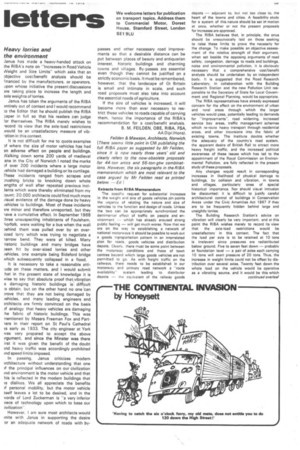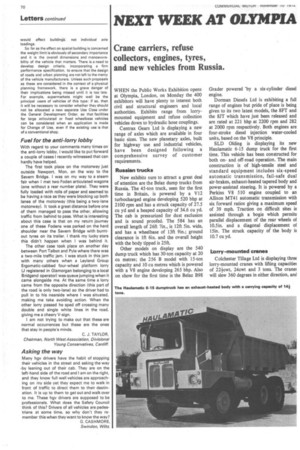Extracts from RI BA Memorandum
Page 67

Page 68

If you've noticed an error in this article please click here to report it so we can fix it.
The specific request for substantial increases in the weight and size of goods vehicles pin-points the urgency of relating the nature and size of vehicles to the function and design of roads. Unless the two can be appropriately synchronized the detrimental effect of traffic on people and environment — which has already aroused strong public feeling — will get much worse: Now that we are on the way to establishing a network of national motorways it should be possible to work out a goods transportation pattern in an interrelated plan for roads, goods vehicles and distribution depots. Clearly, there must be some point between the motorway conditions and those of town centres beyond which large goods vehicles are not permitted to go As with freight traffic on the railways, there needs to be established in our motorway and primary road network a -route availability"' system leading to distributor depots — the equivalent of the railway goods
depots — adjacent to, but not too close to, the heart of the towns and cities. A feasibility study for a system of this nature should be set in' motion at once, whether or not the present proposals for increases are approved.
The RIBA believes that, in principle, the onus should be unequivocally laid on those seeking to raise these limits to prove the necessity for the change. To make possible an objective assessment of the relative strength of their argument, when set beside the opposing arguments of road safety, congestion, damage to roads and buildings, noise and environmental pollution, it is obviously necessary that a comprehensive cost/benefit analysis should be undertaken by an independent body. It is suggested that the Road Research Laboratory, in collaboration with the Building Research Station and the new Pollution Unit responsible to the Secretary of State for Local Government and Regional Planning, would be appropriate.
The RIBA representatives have already expressed concern for the effect on the environment of urban and rural areas through which the larger vehicles would pass, potentially leading to demands for "improvements-, road widening, increased service bay areas, traffic management schemes which re-route heavy transport through residential areas, and other incursions into the fabric of existing towns: The Institute doubts whether the adequacy of the country's road system, the apparent desire of British Rail to attract more heavy freight traffic, and the increased political awareness of these issues which has led to the appointment of the Royal Commission on Environmental Pollution, are fully reflected in the present study of these proposals.
Any changes would result in corresponding increases in likelihood of physical damage to buildings, by collision and vibration, in towns and villages, particularly ones of special historical importance. Nor should visual intrusion be discounted: it is difficult to justify careful architectural control of buildings in Conservation Areas under the Civic Amenities Act 1 967 if they are to be frequently hidden behind large and unsightly lorries.
The Building Research Station's advice on vibration will clearly be very important, and at this point the RIBA wishes merely to record its view that the axle-load restrictions would be unsatisfactory in this context, The fact that the load per axle is to be retained at 10 tons is irrelevant since pressures are redistributed below ground. Five to seven feet down — probably at foundation level 7a pair of axles each carrying 10 tons will exert pressure of 20 tons. Thus, the increase in weight limits could not be offset by distribution over several axles. Twenty feet down the whole load on the vehicle would be operative as a vibrating source, and it would be this which
would affect buildinde not individual axle loadings.
So far as the effect on spatial building is concerned the weight limit is obviously of secondary importance and it is the overall dimensions and manoeuvrability of the vehicle that matters. There is a need to develop design criteria, incorporating a firm performance specification, to ensure that the design of roads and urban planning are not left to the mercy of the vehicle manufacturers. Unless such proposals as these are considered in the context of a physical planning framework, there is a grave danger of their implications being missed until it is too late. For example, supermarkets might well be the principal users of vehicles of this type: if so, then it will be necessary to consider whether they should not be allocated a new separate Use Class under the General Development Order, so that facilities for large articulated or fixed wheelbase vehicles can be considered when an application is made for Change of Use, even if the existing use is that of a conventional shop.




































































































































